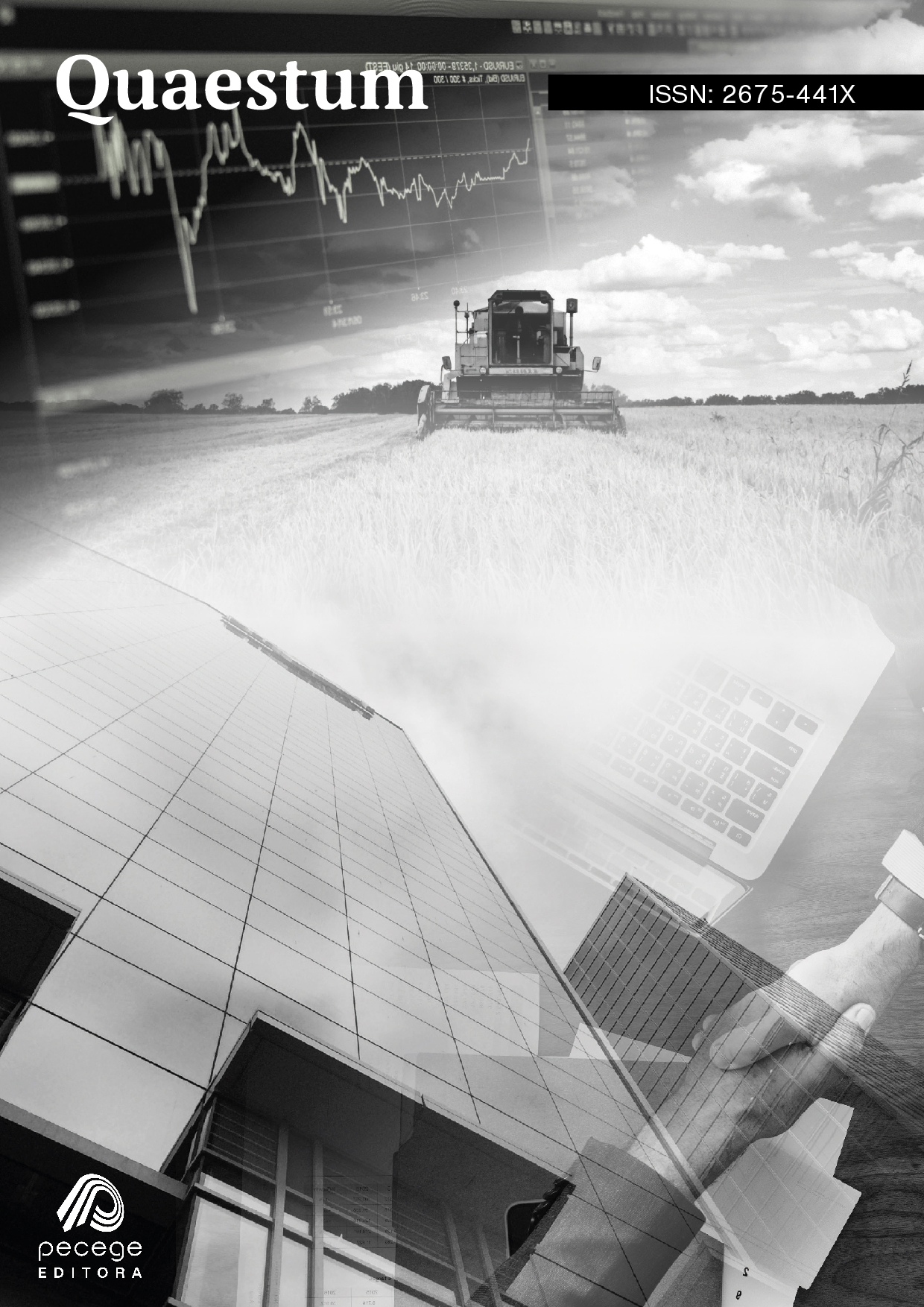Characterization factors for global greenhouse gases emissions applying Machine Learning
Characterizing the global greenhouse gases emissions using machine learning
DOI:
https://doi.org/10.22167/2675-441X-2024741Keywords:
capacidade produtiva econômica, crescimento econômico sustentável, emissões, “random forest”Abstract
Considering the promotion of sustainability practices and policies in the current economic scenario, this work present an evaluation of global socio-economic factors along with greenhouse gases emission profile based on a machine learning approach. The Random Forest algorithm was applied to perform a regression on a database with information on economic growth and greenhouse gas emissions between 1990 and 2018. The database was composed of two main groups representing the major and minor global economies selected by their economic activity level in the period. Initially, the most important features of the study were identified by means of recursive features elimination (RFE) and then the model was trained using cross validation technique before being tested. The model presented good performance metrics without overfitting. In this way, we could identify that the global greenhouse gas emission profile is impacted by specific features depending on the economic activity level. Thus, the analysis presented in this work may contribute to global governments the better understand the priorities and allocate resources wisely to promote sustainable growth.
References
United States Environmental Protection Agency (EPA). 2022. Inventory of U.S. greenhouse gas emissions and sinks: 1990–2020. Disponível em: <https://www.epa.gov/ghgemissions/inventory-us-greenhouse-gas-emissions-and-sinks-1990-2020>. Acesso em: 21 set. 2022.
Vicente, M.C.P. 2016. Cadernos Adenauer XVII, nº 2 — Mudanças climáticas: o desafio do século. Fundação Konrad Adenauer, Rio de Janeiro, RJ, Brasil.
Yoro, K.O.; Daramola, M.O. 2020. CO2 emission sources, greenhouse gases, and the global warming effect. p. 3-28. In: Rahimpour, M.R.; Farsi, M.; Makarem, M.A. (eds.). Advances in Carbon Capture: Methods, Technologies and Applications. Woodhead Publishing, Cambridge, UK. https://doi.org/10.1016/B978-0-12-819657-1.00001-3.
European Environment Agency (EEA). 2023. EMEP/EEA air pollutant emission inventory guidebook 2023. Disponível em: <https://www.eea.europa.eu/publications/emep-eea-guidebook-2023>. Acesso em: 01 mar. 2024.
Environmental Protection Agency (EPA). Understanding global warming potentials. Disponível em <https://www.epa.gov/ghgemissions/understanding-global-warming-potentials>. Acesso em: 12 out. 2023.
Foster, P.; Ramaswamy, V.; Artaxo, P.; Berntsen, T.; Betts, R.; Fahey, D.W.; Haywood, J.; Lean, J.; Lowe, D.C.; Myhre, G.; Nganga, J.; Prinn, R.; Raga, G.; Schulz, M.; Van Dorland, R. 2007. Changes in atmospheric constituents and in radiative forcing. In: Solomon, S.; Qin, D.; Manning, M.; Chen, Z.; Marquis, M.; Averyt, K.B.; Tignor, M.; Miller, H.L. (eds.). Climate Change 2007: the physical science basis. Contribution of working group I to the Fourth Assessment Report of the Intergovernmental Panel on Climate Change. Cambridge University Press, Cambridge, UK. Disponível em <http://www.ipcc.ch/pdf/assessment-report/ar4/wg1/ar4-wg1-chapter2.pdf>. Acesso em: 21 set. 2022.
Feenstra, R.C.; Inklaar, R.; Timmer, M.P. 2015. The next generation of the Penn World Table. American Economic Review 105(10): 3150-3182. https://doi.org/10.1257/aer.20130954.
Climate Watch. 2022. GHG Emissions. World Resources Institute. Disponível em: <https://www.climatewatchdata.org/ghgemissions>. Acesso em: 07 nov. 2022.
Dowrick, S. 2005. The Penn World Table: a review. The Australian Economic Review 38(2): 223-228. https://doi.org/10.1111/j.1467-8462.2005.00369.x.
Instituto Brasileiro de Geografia e Estatística (IBGE). 2022. Produto Interno Bruto – PIB. Disponível em: <https://www.ibge.gov.br/explica/pib.php#:~:text=O%20PIB%20%C3%A9%20a%20soma,R%24%208%2C7%20trilh%C3%B5es.>. Acesso em: 05 nov.2022.
Groningen Growth and Development Centre. 2021. PWT 10.0 Penn World Table version 10.0. https://doi.org/10.15141/S5Q94M.
Crisci, C.; Ghattas, B.; Perera, G. 2012. A review of supervised machine learning algorithms and their applications to ecological data. Ecological Modelling 240: 113-122. https://doi.org/10.1016/j.ecolmodel.2012.03.001.
Boateng, E.Y.; Otoo, J.; Abaye, D.A. 2020. Basic tenets of classification algorithms k-nearest-neighbor, support vector machine, random forest and neural network: a review. Journal of Data Analysis and Information Processing 8(4): 341-357.
Breiman, L. 2001. Random forests. Machine Learning 45: 5-32. Disponível em: <https://link.springer.com/article/10.1023/A:1010933404324>. Acesso em: 13 nov. 2022.
Liaw, A.; Wiener, M. 2002. Classification and Regression by randomForest. R News 2(3): 18-22.
Silva, S.H.G.; Teixeira, A.F.S.; Menezes, M.D.; Guilherme, L.R.G.; Moreira, F.M.S.; Curi, N. 2017. Multiple linear regression and random forest to predict and map soil properties using data from portable X-ray fluorescence spectrometer (pXRF). Ciência e Agrotecnologia 41(6): 648-664. https://doi.org/10.1590/1413-70542017416010317.
Coelho, S.T.; Pereira, A.S.; Bouille, D.H.; Mani, S.K.; Recalde, M.Y.; Savino, A.A.; Stafford, W.H.L. 2020. Overview of Developing Countries. p. 9-61. In: Coelho, S.T.; Pereira, A.S.; Bouille, D.H.; Mani, S.K.; Recalde, M.Y.; Savino, A.A.; Stafford, W.H.L. Municipal solid waste energy conversion in developing countries: technologies, best practices, challenges and policy. Elsevier, Oxford, UK.
Riveira, C. 2017. Mbaku, da Brookings: Ruanda cresce, mas a que preço? Revista Exame. Disponível em: <https://exame.com/mundo/mbaku-da-brookings-ruanda-cresce-mas-a-que-preco/>. Acesso em: 13 nov. 2022.
Ashghal. 2022. Qatar Past, Present and Future. Disponível em: <https://www.ashghal.gov.qa/en/AboutQatar/Pages/Qatar-Today.aspx>. Acesso em: 13 nov. 2022.
Eurostat. 2022. GDP at regional level. Disponível em: <https://ec.europa.eu/eurostat/statistics-explained/index.php title=GDP_at_regional_level>. Acesso em: 13 nov. 2022.
Engdaw, B.D. 2020. Assessment of the trends of greenhouse gas emission in Ethiopia. Geography, Environment, Sustainability 13(2): 135-146. https://doi.org/10.24057/2071-9388-2018-61.
Grisotto, R. 2018. Empreendedorismo na África: novos negócios atraem investidores e gigantes de tecnologia. Disponível em: <https://epocanegocios.globo.com/Empreendedorismo/noticia/2018/05/empreendedorismo-na-africa-novos-negociosatraem-investidores-e-gigantes-de-tecnologia.html>. Acesso em: 12 jan. 2023.
Downloads
Published
How to Cite
Issue
Section
License
Copyright (c) 2024 Quaestum

This work is licensed under a Creative Commons Attribution-NonCommercial 4.0 International License.












